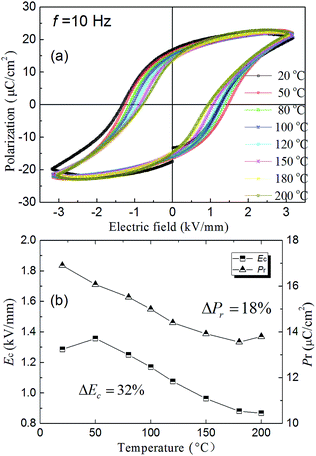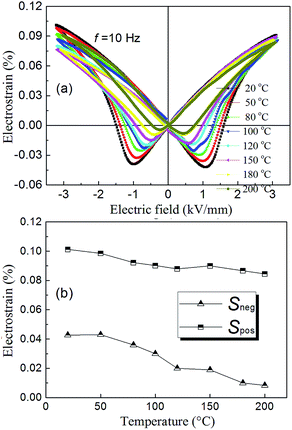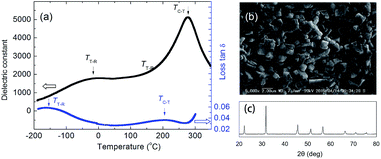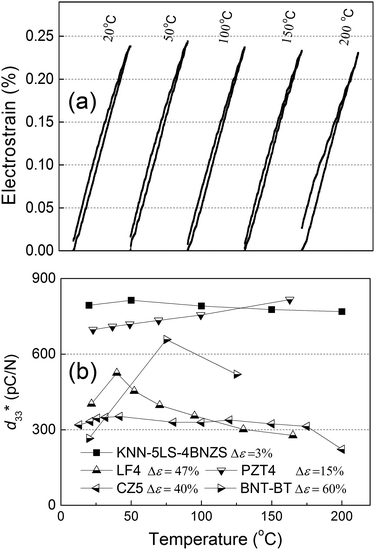 Open Access Article
Open Access ArticleCreative Commons Attribution 3.0 Unported Licence
Large electrostrain with good temperature stability in sodium niobate based ceramics
Wenfeng Liu *,
Daqi Zhao and
Shengtao Li
*,
Daqi Zhao and
Shengtao Li
State Key Laboratory of Electrical Institution and Power Equipment, School of Electrical Engineering, Xi'an Jiaotong University, Xi'an 710049, China. E-mail: liuwenfeng@xjtu.edu.cn
First published on 12th January 2017
Abstract
A large electrostrain of 0.24% with a converse piezoelectric constant of 790 pm V−1 was obtained from the LiSbO3 and (Bi0.5Na0.5)(Zr0.9Sn0.1)O3 modified KNbO3 ceramics. The electrostrain showed good temperature stability with vibration within 3% in the range from room temperature to 200 °C. It can even rival the current working horse PZT4. Besides, the present ceramics exhibited a large d33 of 207 pC N−1. The enhanced piezoelectric properties were achieved by pinching the phase with different symmetries together, experimentally by doping. Here the isovalent additive LiSbO3 was employed to lower the tetragonal to orthorhombic phase transition temperature and to raise the orthorhombic to rhombohedral phase transition temperature, i.e. pinch the three ferroelectric phases together. Meanwhile (Bi0.5Na0.5)(Zr0.9Sn0.1)O3 was used as the aliovalent doping to lower the Tc. It consequently resulted in a decrease of polarization anisotropy between phases with different symmetries and thus led to a large piezoelectric performance.
Introduction
Piezoelectric materials exhibit a shape change to a predefined state upon a change of the electric field. Such materials provide a good solution to the “quick and slim” actuator applications since they guarantee a fast response and their required driven field can be easily applied through very fine guide wires (compared with the bulky magnets required by magnetic-shape-memory materials).1–3 Many applications, typically the actuators, require large electrostrain under a high driving field, and at the present stage this market is dominated by Pb-based materials in the form of the ceramics.4–6 Despite their outstanding performance, Pb-based ferroelectrics are currently facing global restrictions for their toxicity. Besides, the materials have to suffer the variations by changing temperature, emerging from varying ambient conditions as well as from the generation of heat by the inner losses during operation of these devices; thus a significant effort should be directed to develop non-Pb substitutes with both large electrostrain and high temperature stability.Lead zirconate-titanate (PZT) based ceramics, the most widely used piezoelectric ceramics for electro-shape-memory applications, typically show an electrostrain of 0.15% under the electric field of 2 kV mm−1. Meanwhile it exhibits the fluctuation in electrostrain of 15% in the temperature range from room temperature to 200 °C.7 On the other hand, the lead-free candidates show the inferior property. (BiNa)TiO3-based ceramics, as the most promising candidate, can achieve the electrostrain of 0.4%. However, the high driving electric field over 8 kV mm−1 and the large nonlinearity with big strain hysteresis restrict its applications.8 BaTiO3 ceramic material containing Zr additive exhibited electrostrain of 0.18% at 4 kV mm−1,9 and similar results were found for (BaSr)TiO3 ceramics containing Mn additive with 0.12–0.15% electrostriction at 3 kV mm−1. While the main flaw in BaTiO3 based piezoelectric is the low Curie temperature (Tc);10,11 the Curie temperature of pure BaTiO3 is only 130 °C, and additives reduce it further. Thus BaTiO3 based materials can therefore only be used within a narrow range of temperatures (say, 50 °C) in the vicinity of room temperature. In addition, extensive attention is focused on (K,Na)NbO3 based ceramics since the breakthrough made by Saito in 200412 and recently by Wu JG.13–19 CZ5 (0.95(Na0.49K0.49Li0.02)(Nb0.8Ta0.2)O3-0.05CaZrO3) reported by Wang Ke,20 as one of the most promising lead-free substitute, yielded the electrostrain of 0.16% at room temperature with variation less than 10% from room temperature to 175 °C.
In the present paper, we report a promising KNN-based ceramics with even enhanced electrostrain of 0.24% under 3 kV mm−1, which can even rival the current working horse PZT4. Meanwhile such ceramics exhibit remarkable temperature stability of 3% in the temperature range from room temperature to 200 °C. The enhanced electrostrain performance is discussed based on the coexistence of multi-phases, which contributes to the flat polarization rotation energy landscape.
Previous study pointed out that a tetragonal (T)–orthorhombic (O)–rhombohedral (R) phase coexistence gives totally flat polarization rotation energy landscape, while T–O or O–R single phase boundary has relatively large energy barriers. It is highly possible for (K,Na)NbO3 based ceramics, who has a T to O to R ferroelectric transition sequence originally. This can be achieved by doping. Here we chose LiSbO3 to lower T–O transition temperature and to rise O–R transition temperature, i.e. pinch the three ferroelectric phases together. This will create the quadruple point, which may give more polarization instabilities as well as phase similarities and consequently decrease the polarization anisotropy and energy barriers for both polarization rotation (intrinsic contribution) and domain wall motion (extrinsic contribution).21–26 On the other hand, we chose (Bi0.5Na0.5)(Zr0.9Sn0.1)O3 as the aliovalent doping to lower the Tc.27,28 According to Landau theory of phase transition, when temperature is close to Tc, the energy barrier for polarization switching decreases and may benefit the enhanced property at room temperature.
Experimental
The designed sample ceramic 0.96(0.95(K0.48Na0.52)NbO3-0.05LiSbO3)-0.04(Bi0.5Na0.5)(Zr0.9Sr0.1)O3 (abbreviated as KNN-5LS-4BNZS hereafter) were fabricated by the conventional solid state reaction method. Raw materials of Na2CO3 (99.8%), K2CO3 (99%), Li2CO3 (99.9%), Sb2O5 (99.99%), Nb2O5 (99.5%), SnO2 (99.9%), ZrO2 (99%), and Bi2O3 (99.999%) were mixed according to a predetermined ratio with addition of deionized water and planetary ball mixed for 4 h, which were then dried and calcined at 850 °C for 4 h. After the granulation and tableting the specimens were sintered at 1165 °C for 3 h in air.The microstructure and grain-size were measured by SEM (SEM, KEYENCEVE-9800) and Nano Measure software developed by FDU. Dielectric property as a function of temperature (from −200 °C to 350 °C) were determined using two LCR testers (Agilent 4980a for 30 °C to 350 °C and 3532-50 HIOKI for −200 °C to 30 °C) at 10 kHz. Ferroelectric hysteresis loops and electrostrain curves were measured at temperature range from 20 °C to 200 °C using Radiant Workstation and MTI 2000 photic sensor. The frequency of the measurement was fixed at 10 Hz. Piezoelectric constant d33 was measured using a quasi-static d33 meter (ZJ-3B, Institute of Acoustics, Chinese Academy of Sciences, China).
Results and discussion
Fig. 1(a) shows the temperature dependence of dielectric constant and loss tangent for the KNN-5LS-4BNZS ceramics. A dielectric maximum around 5100 under the frequency of 10 kHz is achieved at 270 °C, i.e. its Tc. Here the broad peak indicating the diffusion phase transition region, which can be described by the full width at half maximum (FWHW) of 70 °C. These results indicate the existence of a diffuse phase transition in the present ceramic sample.29,30 Here, the long-range polar order is suppressed by substitution disorder, i.e. by doping extensive point defects. The quenched compositional disorder somehow prevents the normal transition into the phases with macroscopic ferroelectric state. Meanwhile, defect dipoles are formed by the substitution dopants; they act as the inherent force to a decrease of the transition temperature.31 Previous study pointed out that the LiSbO3 may effectively decrease the transition temperature from tetragonal to orthorhombic phase while increase the transition temperature from orthorhombic to rhombohedral phase, i.e. try to pinch all the ferroelectric transitions together by narrow the intermediate orthorhombic phase.13 Within the temperature region, manifested as the plateau in the temperature spectrum of the dielectric constant, multi phases may coexist. Accomplishing with the diffuse phase transition, the domain size always decreases, i.e. the population of domain wall enhances; it may enhance electrostrain which mainly originated from the extrinsic piezoelectric effect dominated by the domain wall motions.32 Fig. 1(b) shows the SEM images of the surface morphologies the ceramics. It indicates that the isotropic grains with the average grain size of 1.37 μm distributed within a wide size region. Fig. 1(c) shows the XRD patterns of the KNN-5LS-4BNZS. The obtained ceramics exhibited pure perovskite structure without any secondary phase.Fig. 2(a) shows the ferroelectric hysteresis loops of the KNN-5LS-4BNZS ceramics under the electric field of 3 kV mm−1 by heating from room temperature up to 200 °C. The maximum polarization Pmax and remnant polarization Pr changed slightly with ΔPmax of 7% and ΔPr of 18% respectively in the wide temperature range. It indicates that the switched polarization state along the direction of the external electric field was of little variation. As another important characteristic for ferroelectric property, the coercive field (Ec) which indicates the energy barrier between the equivalent states of the order parameter decreased on increasing temperature, i.e. when getting closer to its Curie temperature around 270 °C. Although the difference of 32% in Ec, the domain switching behavior with similar Pmax and Pr under comparable large electric field may benefit the temperature stability for domain-switching related applications.
 | ||
| Fig. 2 (a) Ferroelectric hysteresis loops of the KNN-5LS-4BNZS ceramics from room temperature to 200 °C. (b) Variation of the Pr and Ec of the KNN-5LS-4BNZS ceramics with the increasing temperature. | ||
Fig. 3(a) shows the electrostrain behavior in the temperature range from 20 °C to 200 °C. All the electrostrain curves show the typical butterfly shape. Different from the hysteresis loops, which involved all the domain switching, the electrostrain curves only reflected the population of non-180° domain switching. For ferroelectrics, the non-180° polarization switching is always coupled to the lattice strain, an instability in polarization orientation (i.e., isotropy of polarization) will necessarily induce a softening in elastic modulus, and hence a high electrostrain. Therefore, low polarization anisotropy and elastic softening go hands in hands with each other, both contributing to a high electrostrain. As summarized in Fig. 3(b), the Sneg (the strain between minimum strain and strain under zero electric field) of the ceramics decreased. While the Spos (the strain between the maximum strain and the strain under zero electric field) showed little change with 16% in the temperature range from room temperature to 200 °C. It consisted with the hysteresis loop behavior and may benefit the applications with high temperature stability. Such results can be understood by two aspects. Firstly the ceramics are considered to possess multi-phase boundary region at room temperature according to previous report which may greatly enhance the responds under small ac external field, no matter electrical or mechanical. On decreasing the temperature the tetragonality enhanced, i.e. the population of 90°/180° domain increasing. Comparing with the 60°/120° domain for O phase and 71°/109° domain for R phase, such domains morphology in tetragonal phase involves little changes in Sneg. Secondly, even merely considering the tetragonal phase the tetragonality c/a decreased when approaching its Tc; it may consequently decrease the Sneg. At room temperature the total electrostrain of 0.15% under the electric field of 3 kV mm−1 can be expressed by the converse piezoelectric coefficient  of 500 pm V−1 (
of 500 pm V−1 ( = Smax/Emax, where Smax and Emax denote the maximum strain and the maximum electric field strength, respectively) under the bipolar strain from the unpoled ceramics. It is superior the normal KNbO3 based ceramics with
= Smax/Emax, where Smax and Emax denote the maximum strain and the maximum electric field strength, respectively) under the bipolar strain from the unpoled ceramics. It is superior the normal KNbO3 based ceramics with  of 100–200 pm V−1.
of 100–200 pm V−1.
 | ||
| Fig. 3 (a) Electrostrain loops of the KNN-5LS-4BNZS ceramics from room temperature to 200 °C. (b) Variation of the Sneg and Spos of the KNN-5LS-4BNZS ceramics with increasing temperature. | ||
More interestingly, large electrostrain over 0.24% under the electric field of 3 kV mm−1 can be achieved after poling treatment. Here the ceramic sample was poled at room temperature under the electric field of 5 kV mm−1 for 10 min. Previous study has reported the excellent electrostrain behaviors in the KNN-based ceramics; CZ5 (0.95(Na0.19K0.49Li0.02)(Nb0.8Ta0.2)O3-0.05CaZrO3) reported by Wang20 exhibited the strain of 0.16% at 6 kV mm−1 and textured LF4 reported by Saito showed the electrostrain of 0.17% at 2 kV mm−1 (while untextured showed strain of only 0.085% at 2 kV mm−1).12 The KNN-5LS-4BNZT ceramics showed even more promising performance at room temperature.
Fig. 4(b) shows the comparison of the strain behavior in wide temperature range between the KNN-5LS-4BNZT ceramics and other high-performed piezoelectric ceramics, including PZT4 ceramics, which is famous for its high electrostrain and good temperature stability. Here the strain behavior is characterized by the normalized piezoelectric coefficient  . We concluded that the
. We concluded that the  of the KNN-5LS-4BNZT ceramics exceed that of the CZ5 and Bi-based lead-free ceramics in wide temperature range. Even more, it can rival the most widely used PZT4 ceramics and the textured LF4 which suffered a very complex texturing technology. Besides, such electrostrain exhibited excellent temperature stability with Δε of 3% in the wide temperature range from room temperature to 200 °C, which is even superior to the PZT4 with Δε of 15% and textured LF4 Δε of 7%. From Fig. 4(a) we notice that KNN-5LS-4BNZT exhibited small hysteresis in the strain-electric field curves besides the good electrostrain behavior, which can be defined as the area within the strain curves. Such small hysteresis possess two advantages, one is the high accuracy between the forward and the backward processes while the other is the small energy loss when cycling. Additionally, the present KNN-5LS-4BNZT exhibited a large d33 of 207 pC N−1. It is also promising for lead-free piezoelectric material which may trigger the applications under small signal, e.g. the sensors.
of the KNN-5LS-4BNZT ceramics exceed that of the CZ5 and Bi-based lead-free ceramics in wide temperature range. Even more, it can rival the most widely used PZT4 ceramics and the textured LF4 which suffered a very complex texturing technology. Besides, such electrostrain exhibited excellent temperature stability with Δε of 3% in the wide temperature range from room temperature to 200 °C, which is even superior to the PZT4 with Δε of 15% and textured LF4 Δε of 7%. From Fig. 4(a) we notice that KNN-5LS-4BNZT exhibited small hysteresis in the strain-electric field curves besides the good electrostrain behavior, which can be defined as the area within the strain curves. Such small hysteresis possess two advantages, one is the high accuracy between the forward and the backward processes while the other is the small energy loss when cycling. Additionally, the present KNN-5LS-4BNZT exhibited a large d33 of 207 pC N−1. It is also promising for lead-free piezoelectric material which may trigger the applications under small signal, e.g. the sensors.
Conclusions
In summary, a new electro-shape-memory material with great strain behavior and temperature stability KNN-5LS-4BNZS ceramic has been synthesized by conventional solid-state reaction method. A unipolar strain of 0.24% with a slim electrostrain curve under an electric field of 3 kV mm−1 is achieved after poled. Furthermore, a variation of only 3% of the strain behavior is obtained when heating to 200 °C. Such splendid performances can be applied to actuators with the demands of high precision and good thermal stability and surely challenge the current mainstream lead-based material PZT4. We believe the coexistence of the ferroelectric phases may attribute to the excellent strain behavior of the samples and the small variations of Pr and Spos with increasing temperature would help to explain the steady thermal performance of the ceramic.Acknowledgements
The authors acknowledge the support of National Nature Science Foundation of China (51422704) and State Key of Laboratory of Electrical Insulation and Power Equipment, Xi'an Jiaotong University (EIPE14113).Notes and references
- L. X. Zhang and X. Ren, Mater. Sci. Eng., A, 2006, 438, 354 CrossRef.
- K. Bhattacharya and G. Ravichandran, Acta Mater., 2003, 51, 5941 CrossRef CAS.
- K. Uchino, Am. Ceram. Soc. Bull., 1986, 65, 647 CAS.
- B. Jaffe, Piezoelectric Ceramics, Academic Press, London, 1971 Search PubMed.
- L. E. Cross, S. J. Jang, R. E. Newnham, S. Nomura and K. Uchino, Ferroelectrics, 1980, 23, 187 CrossRef CAS.
- Y. Dai, Y. Chen, H. Shen, Z. Zhang and Y. Wang, Ferroelectrics, 2001, 251, 77 CrossRef CAS.
- S. E. Park and T. R. Shrout, J. Appl. Phys., 1997, 82, 1804 CrossRef CAS.
- S. T. Zhang, A. B. Kounga, W. Jo, C. Jamin, K. Seifert, T. Granzow, J. Rodel and D. Damjanovic, Adv. Mater., 2009, 21, 4716 CrossRef CAS.
- Z. Yu, C. Ang, R. Guo and A. S. Bhalla, Appl. Phys. Lett., 2002, 92, 1489 CAS.
- L. X. Zhang, W. Chen and X. Ren, Appl. Phys. Lett., 2004, 85, 5658 CrossRef CAS.
- W. F. Liu, W. Chen, L. Yang, L. X. Zhang, Y. Wang, C. Zhou, S. T. Li and X. Ren, Appl. Phys. Lett., 2006, 89, 172908 CrossRef.
- Y. Saito, H. Takao, T. Tani, T. Nonoyama, K. Takatori, T. Homma, T. Nagaya and M. Nakamura, Nature., 2004, 432, 84 CrossRef CAS PubMed.
- J. G. Wu, D. Q. Xiao and J. G. Zhu, Chem. Rev., 2015, 115, 2559 CrossRef CAS PubMed.
- X. Lv, J. G. Wu, D. Q. Xiao, H. Tao, Y. Yuan, J. G. Zhu, X. J. Wang and X. J. Lou, Dalton Trans., 2015, 44, 4440 RSC.
- X. P. Wang, J. G. Wu, D. Q. Xiao, X. J. Cheng, T. Zheng, X. J. Lou, B. Y. Zhang and J. G. Zhu, ACS Appl. Mater. Interfaces, 2014, 6, 6177 CAS.
- H. Tao, J. G. Wu, D. Q. Xiao, J. G. Zhu, X. P. Wang and X. J. Lou, ACS Appl. Mater. Interfaces, 2014, 6, 20358 CAS.
- T. Zheng, J. G. Wu, X. J. Cheng, X. P. Wang, B. Y. Zhang, D. Q. Xiao, J. G. Zhu, X. J. Wang and X. J. Lou, J. Mater. Chem. C, 2014, 2, 8796 RSC.
- K. Xu, J. Li, X. Lv, J. Wu, X. Zhang, D. Xiao and J. Zhu, Adv. Mater., 2016, 28, 8519 CrossRef CAS PubMed.
- B. Wu, H. Wu, J. Wu, D. Xiao, J. Zhu and S. J. Pennycook, J. Am. Chem. Soc., 2016, 138, 15459 CrossRef CAS PubMed.
- K. Wang, F. Z. Yao, W. Jo, D. Gobeljic, V. V. Shvartsman, D. C. Lupascu, J. F. Li and J. Rödel, Adv. Funct. Mater., 2013, 23, 4079 CrossRef CAS.
- Y. G. Yao, C. Zhou, D. C. Lv, D. Wang, H. J. Wu, Y. D. Yang and X. B. Ren, Europhys. Lett., 2012, 98, 27008 CrossRef.
- J. Rödel, W. Jo, K. T. P. Seifert, E. Anton, T. Granzow and D. Damjanovic, J. Am. Ceram. Soc., 2009, 92, 1153 CrossRef.
- M. Acosta, N. Khakpash, T. Someya, N. Novak, W. Jo, H. Nagata, G. A. Rossetti Jr and J. Rödel, Phys. Rev. B: Condens. Matter Mater. Phys., 2015, 91, 104108 CrossRef.
- A. A. Heitmann and G. A. Rossetti, J. Am. Ceram. Soc., 2014, 97, 1661 CrossRef CAS.
- W. F. Rao and Y. U. Wang, Appl. Phys. Lett., 2008, 92, 102905 CrossRef.
- W. F. Rao and Y. U. Wang, Appl. Phys. Lett., 2007, 91, 052901 CrossRef.
- X. P. Wang, J. G. Wu, X. J. Cheng, B. Y. Zhang, J. G. Zhu and D. Q. Xiao, Ceram. Int., 2013, 39, 8021 CrossRef CAS.
- J. Wu, D. Xiao and J. Zhu, J. Mater. Sci.: Mater. Electron., 2015, 26, 9297 CrossRef CAS.
- R. Thomas, V. K. Varadan, S. Komarneni and D. C. Dube, J. Appl. Phys., 2001, 90, 1480 CrossRef CAS.
- W. F. Liu, S. Tsukada and Y. Akishige, Funct. Mater. Lett., 2014, 7, 599 Search PubMed.
- A. Dixit, S. B. Majumder, R. S. Katiyar and A. S. Bhalla, Appl. Phys. Lett., 2003, 82, 2679 CrossRef CAS.
- D. Damjanovic, Hysteresis in Piezoelectric and Ferroelectric Materials, Academic Press-Elsevier, New York, 2006 Search PubMed.
| This journal is © The Royal Society of Chemistry 2017 |


